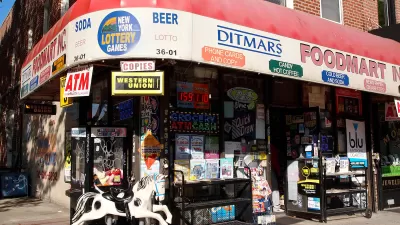A recent study strengthens the economic case for walkable communities, finding a strong inverse relationship between walkscore and risk of mortgage default.

A recent study from University of Arizona professor Gary Pivo and strengthens the economic case for walkable communities. Pivo looked at the relationship between mortgage default and walk scores for multifamily housing. He found a strong inverse relationship: low walk scores were associated with high risk of mortgage default, and high walk scores were associated with low risk of mortgage default. The relationship was strongest at the extremes:
“Where walk score was 80 or more (out of 100), the relative risk of default is 60 percent lower than where walk score is less than 80. Where walk score is 8 or less, default risk is 121 percent higher.”
These findings turn common beliefs upside down, showing that the most walkable developments are not, in fact, risky propositions. In general, in the past, it has been more difficult to finance projects in walkable areas. There are many reasons for this, but it boils down to a perception of risk on the part of lenders.
For example, the mixed-use nature of the walkable neighborhoods—with both commercial and residential space in close proximity, sometimes housed in a single building—is considered more complex for developers, financiers and investors. This complexity leads to the perception of risk, although Pivo notes, it is “unclear exactly what it is about the projects that are cause for concern.”
Furthermore, demand for housing in walkable areas appears to be on the rise. Pivo cites a study from the Urban Land Institute which found that “demand and interest in apartments in ‘American infill’ locations remain hot.” Community preference surveys from the National Association of Realtors indicate increased demand for mixed use neighborhoods, transportation choices, and short commutes. The Sonoran Institute's RESET study looked at six communities in the Rocky Mountain West, and found in most cases that people are willing to pay a premium for housing in compact, walkable neighborhoods.
So, research indicates that walkable housing is a lower-risk investment—there is consumer demand, and low likelihood of mortgage default. Walkability has also been shown to have multiple other advantages, like improved public health, reduced carbon footprint, and less pollution.
To promote walkable development, Pivo recommends that lenders offer better terms for mortgages on walkable properties. Developers consistently cite difficulty in securing financing as one of the biggest barriers to the success of mixed use and other walkable developments. It’s time to remove that barrier, and recognize the investment opportunity that awaits in these great neighborhoods.
FULL STORY: Community Builders Blog

Trump Administration Could Effectively End Housing Voucher Program
Federal officials are eyeing major cuts to the Section 8 program that helps millions of low-income households pay rent.

Planetizen Federal Action Tracker
A weekly monitor of how Trump’s orders and actions are impacting planners and planning in America.

Ken Jennings Launches Transit Web Series
The Jeopardy champ wants you to ride public transit.

Rebuilding Smarter: How LA County Is Guiding Fire-Ravaged Communities Toward Resilience
Los Angeles County is leading a coordinated effort to help fire-impacted communities rebuild with resilience by providing recovery resources, promoting fire-wise design, and aligning reconstruction with broader sustainability and climate goals.

When Borders Blur: Regional Collaboration in Action
As regional challenges outgrow city boundaries, “When Borders Blur” explores how cross-jurisdictional collaboration can drive smarter, more resilient urban planning, sharing real-world lessons from thriving partnerships across North America.

Philadelphia Is Expanding its Network of Roundabouts
Roundabouts are widely shown to decrease traffic speed, reduce congestion, and improve efficiency.
Urban Design for Planners 1: Software Tools
This six-course series explores essential urban design concepts using open source software and equips planners with the tools they need to participate fully in the urban design process.
Planning for Universal Design
Learn the tools for implementing Universal Design in planning regulations.
Ada County Highway District
Clanton & Associates, Inc.
Jessamine County Fiscal Court
Institute for Housing and Urban Development Studies (IHS)
City of Grandview
Harvard GSD Executive Education
Toledo-Lucas County Plan Commissions
Salt Lake City
NYU Wagner Graduate School of Public Service





























